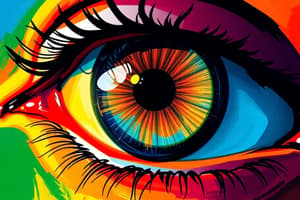Podcast
Questions and Answers
The human eye is like a ______.
The human eye is like a ______.
camera
The human eye uses ______ and enables us to see objects around us.
The human eye uses ______ and enables us to see objects around us.
light
Light enters the eye through a thin membrane called the ______.
Light enters the eye through a thin membrane called the ______.
cornea
The ______ system forms an image on a light-sensitive screen called the retina.
The ______ system forms an image on a light-sensitive screen called the retina.
The human eye is one of the most valuable and sensitive ______ organs.
The human eye is one of the most valuable and sensitive ______ organs.
The ______ is a delicate membrane having enormous number of light-sensitive cells.
The ______ is a delicate membrane having enormous number of light-sensitive cells.
The ______ muscles contract when you are looking at objects closer to the eye.
The ______ muscles contract when you are looking at objects closer to the eye.
The ability of the eye lens to adjust its focal length is called ______.
The ability of the eye lens to adjust its focal length is called ______.
The minimum distance, at which objects can be seen most distinctly without strain, is called the ______ distance of distinct vision.
The minimum distance, at which objects can be seen most distinctly without strain, is called the ______ distance of distinct vision.
The ______ point of the eye is the farthest point upto which the eye can see objects clearly.
The ______ point of the eye is the farthest point upto which the eye can see objects clearly.
Flashcards are hidden until you start studying
Study Notes
The Human Eye
- The human eye is a sense organ that enables us to see the world around us, with the ability to identify colors.
- It is like a camera, with a lens system that forms an image on a light-sensitive screen called the retina.
Structure of the Eye
- The eye has a transparent bulge on the front surface called the cornea, where light enters the eye.
- The eyeball is approximately spherical in shape with a diameter of about 2.3 cm.
- The iris is a dark muscular diaphragm that controls the size of the pupil, regulating the amount of light entering the eye.
- The crystalline lens provides finer adjustment of focal length to focus objects at different distances on the retina.
Power of Accommodation
- The eye lens is composed of a fibrous, jelly-like material that can change its curvature to modify its focal length.
- The ciliary muscles can modify the curvature of the eye lens to focus on objects at different distances.
- The ability of the eye lens to adjust its focal length is called accommodation.
- The focal length of the eye lens cannot be decreased below a certain minimum limit.
Least Distance of Distinct Vision
- The minimum distance at which objects can be seen most distinctly without strain is called the least distance of distinct vision or near point of the eye.
- For a young adult with normal vision, the near point is about 25 cm.
Far Point of the Eye
- The farthest point up to which the eye can see objects clearly is called the far point of the eye.
- For a normal eye, the far point is infinity.
Vision Defects
- Sometimes, the crystalline lens of people at old age becomes milky and cloudy, leading to defects in vision.
- Lenses used in spectacles can correct defects of vision.
Studying That Suits You
Use AI to generate personalized quizzes and flashcards to suit your learning preferences.




